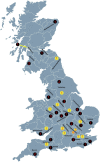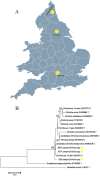Detection of tick-borne bacteria and babesia with zoonotic potential in Argas (Carios) vespertilionis (Latreille, 1802) ticks from British bats
- PMID: 29382871
- PMCID: PMC5789838
- DOI: 10.1038/s41598-018-20138-1
Detection of tick-borne bacteria and babesia with zoonotic potential in Argas (Carios) vespertilionis (Latreille, 1802) ticks from British bats
Abstract
Ticks host a wide range of zoonotic pathogens and are a significant source of diseases that affect humans and livestock. However, little is known about the pathogens associated with bat ticks. We have collected ectoparasites from bat carcasses over a seven year period. Nucleic acids (DNA and RNA) were extracted from 296 ticks removed from bats and the species designation was confirmed in all ticks as Argas (Carios) vespertilionis. A subset of these samples (n = 120) were tested for the presence of zoonotic pathogens by molecular methods. Babesia species, Rickettsia spp., within the spotted fever group (SFG), and Ehrlichia spp. were detected in ticks removed from 26 bats submitted from 14 counties across England. The prevalence of Rickettsia spp. was found to be highest in Pipistrellus pipistrellus from southern England. This study suggests that the tick species that host B. venatorum may include the genus Argas in addition to the genus Ixodes. As A. vespertilionis has been reported to feed on humans, detection of B. venatorum and SFG Rickettsia spp. could present a risk of disease transmission in England. No evidence for the presence of flaviviruses or Issyk-Kul virus (nairovirus) was found in these tick samples.
Conflict of interest statement
The authors declare that they have no competing interests.
Figures





Similar articles
-
Rickettsiae in the common pipistrelle Pipistrellus pipistrellus (Chiroptera: Vespertilionidae) and the bat soft tick Argas vespertilionis (Ixodida: Argasidae).Parasit Vectors. 2020 Jan 9;13(1):10. doi: 10.1186/s13071-020-3885-x. Parasit Vectors. 2020. PMID: 31918751 Free PMC article.
-
Borrelia, Rickettsia, and Ehrlichia species in bat ticks, France, 2010.Emerg Infect Dis. 2012 Dec;18(12):1966-75. doi: 10.3201/eid1812.111237. Emerg Infect Dis. 2012. PMID: 23171714 Free PMC article.
-
Babesia vesperuginis in Common Pipistrelle ( Pipistrellus pipistrellus) and the Bat Soft Tick Argas vespertilionis in the People's Republic of China.J Wildl Dis. 2018 Apr;54(2):419-421. doi: 10.7589/2017-08-206. Epub 2018 Jan 29. J Wildl Dis. 2018. PMID: 29377752
-
[Tick borne zoonosis: selected clinical and diagnostic aspects].Parassitologia. 2004 Jun;46(1-2):109-13. Parassitologia. 2004. PMID: 15305697 Review. Italian.
-
Ticks (Acari: Ixodidae) and tick-borne diseases in Cameroon: Current understanding and future directions for more comprehensive surveillance.One Health. 2024 Dec 9;20:100949. doi: 10.1016/j.onehlt.2024.100949. eCollection 2025 Jun. One Health. 2024. PMID: 39816239 Free PMC article. Review.
Cited by
-
Novel Genotypes of Nidicolous Argas Ticks and Their Associated Microorganisms From Spain.Front Vet Sci. 2021 Mar 29;8:637837. doi: 10.3389/fvets.2021.637837. eCollection 2021. Front Vet Sci. 2021. PMID: 33855055 Free PMC article.
-
Zoonotic Babesia: A scoping review of the global evidence.PLoS One. 2019 Dec 30;14(12):e0226781. doi: 10.1371/journal.pone.0226781. eCollection 2019. PLoS One. 2019. PMID: 31887120 Free PMC article.
-
Novel symbionts and potential human pathogens excavated from argasid tick microbiomes that are shaped by dual or single symbiosis.Comput Struct Biotechnol J. 2022 Apr 19;20:1979-1992. doi: 10.1016/j.csbj.2022.04.020. eCollection 2022. Comput Struct Biotechnol J. 2022. PMID: 35521555 Free PMC article.
-
Molecular detection of vector-borne bacteria in bat ticks (Acari: Ixodidae, Argasidae) from eight countries of the Old and New Worlds.Parasit Vectors. 2019 Jan 22;12(1):50. doi: 10.1186/s13071-019-3303-4. Parasit Vectors. 2019. PMID: 30670048 Free PMC article.
-
Bat-associated ticks as a potential link for vector-borne pathogen transmission between bats and other animals.PLoS Negl Trop Dis. 2024 Oct 25;18(10):e0012584. doi: 10.1371/journal.pntd.0012584. eCollection 2024 Oct. PLoS Negl Trop Dis. 2024. PMID: 39453968 Free PMC article.
References
-
- Helversen, O.V., Nill, D. & Dietz, C. Bats of Britain, Europe and Northwest Africa. Bloomsbury Specialist (2009).
Publication types
MeSH terms
Substances
LinkOut - more resources
Full Text Sources
Other Literature Sources
Medical
Research Materials
Miscellaneous

